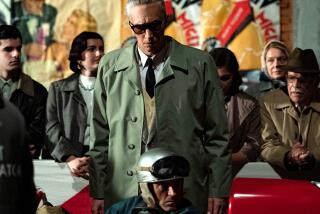Sorry, Ferrari : The Public Has Shifted Gears, Leaving Boom Years for the Plush Cars in the Dust
- Share via
COSTA MESA — This isn’t exactly a Ferrari kind of neighborhood. Next door is a company that sells boat toilets, and across the street is an auto upholstery shop. The “roach coach” comes around every morning with doughnuts and coffee.
Yet it costs nearly $600,000 to buy the three cars in the tiny showroom. Out back, they’ll spend half a year--and charge $150,000--to restore a Ferrari so it looks exactly the way it did the day it rolled out of the factory in 1956, right down to the ashtray.
A few years ago, you couldn’t get near some of these vintage cars for less than $1 million. But the air’s gone out of the market for exotic cars such as Ferraris.
They’re a bust as rolling status symbols, too, now that ‘80s-style greed is no longer fashionable. In fact, what happened to Ferrari is a good metaphor for the 1980s: big-bucks deals, indecent profits, and a market that turned out to be as fragile as Baccarat crystal.
Now the speculators are gone, and places such as European Auto Sales are once again catering to the hobbyists: middle-aged CEOs and twentysomething heirs with too much money and too little regard for life and limb. In fact, “never crashed” is a big selling point for a vintage Ferrari.
Considering that these are Ferraris we’re talking about, the hobbyists are picking them up cheap. Most sellers are getting less than two-thirds what they’re asking these days.
But at least, as Ferrari dealers like to say, once again “there’s a butt for every seat.”
In the 1980s, the decade of Big Toys, a new Ferrari was one of the signs you’d arrived. Many who’d made a bundle bought one.
Steven D. Wymer, the Newport Beach investment adviser who defrauded dozens of cities out of more than $100 million, drove a white one. Wall Street investment banker Dennis B. Levine, of insider trading fame, had a red one. Even private detectives--at least on TV--drove them. “Magnum, P.I.,” for instance, is credited with a lot of Ferrari sales.
So many people were buying new cars that there was a five-year waiting list at such dealerships as Hollywood Sports Cars--Los Angeles being the world’s biggest Ferrari market.
By the time you drive most new cars off the lot, they’re already depreciating. But Ferrari buyers were scarcely out on the street before they were being offered as much as triple the sticker price. On a $150,000 car, that was several hundred thousand dollars in profit.
Says a rueful Chic Vandagriff, president of Hollywood Sports Car: “We were giving away a million dollars a year.”
Because new cars often weren’t available at any price, people started looking around for older ones as investments.
After the stock market crash in 1987, many began looking for what seemed to be safe investments--hard assets such as vintage cars, office buildings and Impressionist paintings. For a while, prices of vintage Ferraris doubled every year.
Take the 275 GTB/4 (Ferraris tend to have just letters and numbers representing the size of the engine). Ferrari made 330 of these speedy little jobs between 1966 and 1968. In 1985 you could pick one up for $75,000. Every year for the next four years, the price doubled until in 1989 it hit $1.2 million.
There had been Ferrari frenzies before. But nothing like this.
One factor was that Enzo Ferrari, the company’s patriarch, was nearing 90 in the mid-1980s. (He died in 1988.) Speculators bet the price of the cars would go through the roof when he died, and they were right--for a while.
Other exotic machines--Aston-Martin, Lotus, Lamborghini--jumped too. But Ferrari led the pack. No car has won as many races; and after all, what sells the car is the romance of the Ferrari name and the image of guys in helmets and goggles and scarves roaring through the turns at Le Mans.
And there weren’t that many vintage Ferraris to be had. The company made only 7,500 cars in its first 21 years, until 1969, when Fiat bought half the operation and the cars began to lose the racing look. About 5,000 were considered collectible, the rest relegated to the junk heap.
Investors got banks to lend them money on their vintage Ferraris--so they could buy more Ferraris. Some enterprising owners even got banks to lend them cash to build shopping centers and hotels with the cars as collateral.
The boom, alas, didn’t last. The recession took a bigger bite out of the upper middle class than recessions normally do. And the luxury tax--10% on anything you pay for a car over $30,000--hurt, too. By 1990, it was all over.
A lot of banks wound up owning Ferraris that weren’t worth nearly as much as what they’d loaned on them. That 275 GTB/4, for instance, is no longer a million-dollar car; it’s back in the $300,000 ballpark.
As for new Ferraris, some 1991 Testarossas are still languishing in showrooms around the country. Wary banks won’t finance buyers of new Ferraris anymore, so the car maker recently started its own finance company. For the first time since 1981, there’s no waiting list at Hollywood Sports Cars.
“The speculators in vintage cars lost their butts,” says Gerald L. Roush, publisher of the Ferrari Market Letter, “because they didn’t give a damn about Ferraris. They’d have been just as happy speculating in South African mushroom futures.
“They ruined the market for real Ferrari enthusiasts.”
So who buys them these days?
In a word, men--rich men. One of European Auto’s customers is a Hong Kong heir with an allowance of $5 million a month. A few even own more than 10 cars.
Take Skeets Dunn of San Diego, who’s in municipal bonds as a partner for a Wall Street brokerage. Dunn is 49 and has been collecting Ferraris since his early 30s. He owns 14, four of them bought in the last three months. “You can buy them,” he says, “for 25 cents on the dollar compared to what people were asking a few years ago.”
He drives all 14. “You have to drive ‘em at least once a month,” he says. “The worst thing you can do is let ‘em sit around. The seals all dry up.”
But most Ferrari nuts--like Walt Ward of Lemon Heights--own only one. Ward, retired early from his machine-tool business, bought his Ferrari 246 GTS brand new in 1974 for $21,000. It’s worth about $75,000 now. It has only 35,000 miles--and no dents--on it.
Some of his colleagues in the local Ferrari club aren’t so lucky.
“With a good many Ferrari owners, their bravery exceeds their skill,” he says. “So they slide the car into a bank or wrap it around a tree.
“My wife, on the other hand, has convinced me I should die of old age.”
These are, after all, machines designed by a guy whose passion was racing cars. The new F-40, for instance, goes from 0 to 60 in 3.5 seconds. Top speed is 200 m.p.h.
A Ferrari is not so much a car as a dream made palpable in metal and leather, an extravagant fantasy, all clean, graceful lines and luscious curves, an aesthetic attained by very few machines-- a sort of objet d’art on wheels. (“I don’t consider myself a car dealer,” says one new-car salesman. “I’m more like an art dealer.”)
Partisans of Italian cars, in fact, like to think of such German car-makers as Porsche as stodgy. “The style never changes,” says one. “It’s like their design department was still out at Oktoberfest.”
In European Auto’s little showroom there are few walk-ins, the lifeblood of most auto dealerships. Many of the deals here, in fact, are done by fax from all over the world.
Here’s what’s currently available, with relevant history:
* 1956 OSCA, a low-slung red bullet with a cramped cockpit and no roof. In 1957, it made the last Mille Miglia from the town of Brescia to Rome and back, a grueling 11-hour race down narrow country roads at up to 160 m.p.h. The race ended that year because so many drivers--and spectators--were getting killed. Priced to move at $240,000.
* Light-blue 1965 275 GTS convertible (only 200 were made). For a Ferrari, it looks almost comfortable, with the dove-gray leather seats and black carpets. With only 52,000 miles on it, it’s a steal at $175,000.
* 512 Testarossa, 1992, a rocket on wheels with a scant 1,800 miles. It’s all edges and sharp angles painted in a bright shade of what the salesmen call “arrest-me red.” The dealer’s sticker is still in the car: $189,500. It gets 11 miles to the gallon in the city; 16 on the freeway. Asking price: $160,000.
Behind the showroom is a million-dollar row of vintage cars, each with a canvas tarp to keep off the dust.
There’s a 275 GTB made specially in 1964 for Battista Pininfarina, the man who designed many of Ferraris most famous body styles. If you’re over 5-foot-7, you won’t fit in it: The car was built to make the short Pininfarina look taller behind the wheel. He gave it to a dealer in Milan, who sold it to an American. The car wound up with a developer in the Bay Area who went bust.
It was bought by a diaper-manufacturing magnate from Hong Kong, who sent it to European Auto for a $175,000 restoration.
A 31-year-old salesman named Brian Keegan spent weeks tracking down photos of the car that were nearly as old as himself.
One showed a dashboard-mounted stopwatch for road racing that’s no longer made. A replica had to be fashioned by hand.
“I hadda be a detective to find a lot of this stuff,” says Keegan.
Despite all that primping, the judges at the nation’s snazziest Ferrari show--Pebble Beach’s Concours D’Elegance--turned up their noses at the wiper blades, which were English. They took off a half a point; the car finished second.
The diaper magnate wasn’t even there. He’d left early to avoid the crowds. As a matter of fact, he doesn’t drive the car, just flies in from Hong Kong to lift the tarp and peek at it occasionally.
Even European Auto’s owner, who started out importing Volkswagen buses in the ‘60s, will cheerfully admit there’s something a little obscene about spending this much money on a car.
“A million-dollar car is criminally insane,” says Mike Sheehan, 43. “It’s demented.”
But then, he doesn’t even drive a Ferrari anymore.
“Look, I’m an old guy,” he says. “I want to be comfortable when I drive. I want to be able to listen to Beethoven’s 7th, maybe talk on the phone.
“And besides, it’s no longer socially acceptable to drive one.”






